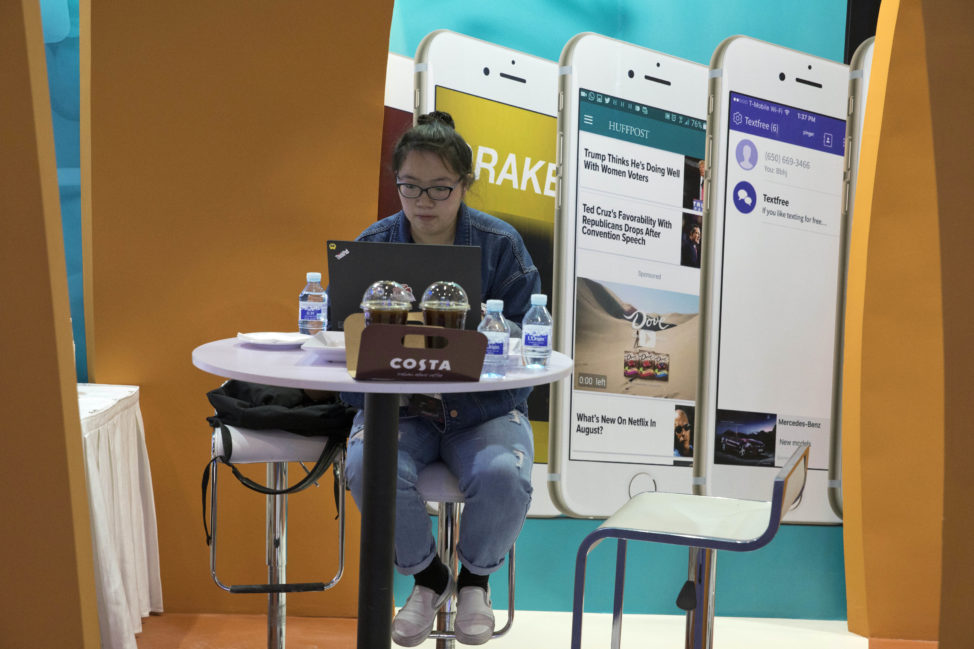
FILE – A woman uses a computer at the Global Mobile Internet Conference in Beijing, China, April 28, 2017. (AP)
A new generation of young people is dominating internet use around the world, thanks to the increased availability of mobile broadband. And their sheer numbers are helping close digital gender gaps along the way.
Global youth “are embracing the emerging technologies, they are using social media, and that is a game-changer in itself,” said Cosmas Zavazava, chief of the projects and knowledge management department at the International Communications Union (ITU) and a Zimbabwe national.
China and India are at the forefront of this shift. In China, home to more than 1.3 billion people, internet content is produced locally and “there is a lot of communication taking place domestically,” he said. “That accounts for the huge usage by young people.”
Population size also pushes up the numbers in India’s urban areas, where more than 32 percent of the population lives and has access to unlimited internet.
The two countries combined account for 320 million internet users between the ages of 15 and 24, according to the ITU’s latest report, ICT Facts and Figures 2017. That’s 39 percent of the world’s total online youth population of 830 million.
Quick Facts
- Only 30 percent of people 15-24-year old are connected in the world’s least developed countries
Proportion of women online in Africa is 25 percent lower than that of men on the internet
- Worldwide, there are 12 percent fewer women than men online
Source: CT Facts and Figures 2017
The uptick in connectivity is due to increased mobile and cellular coverage, competitive subscription bundles, the availability of cheap prepaid SIM cards, and government policies.
This in turn is helping narrow the digital gender gap, particularly in remote rural areas where fixed internet networks are unavailable or are prohibitively expensive.
In the Americas, which are leading the world with the number of women going online, the region’s policies “have enabled women to take IT seriously,” said Zavazava.
And there are “more women using IT than men” in the Caribbean, he noted. They are also working in that sector. “The rest of the world will be playing catch-up,” he said
The driving force behind this gender issue is the issue of broadband – ITU’s Cosmas Zavazava
But the picture is far from even. The proportion of women using the internet in Africa, many of whom live in rural areas, is 25 percent lower than the proportion of men online, according to the ITU’s report.
Rolling out internet services in large rural areas, where more than 70 percent of Africa’s population lives, is a challenge. “If you look at the mobile broadband in Africa,” he said, “it is still lagging behind although it is the faster-growing region of the world in terms of cellular, mobile.”
Other factors also impact the digital gender gap, such as regulations, education, and social and economic discrepancies. But despite “fundamental constraints,” he said “great progress” has been made.
Competing mobile broadband operators, propelled by deregulation and market dynamics, are lowering prices and offering more affordable packages, even in some of the continent’s least developed countries. And many governments have the regulations and the political will to provide more affordable mobile and fixed broadband.
“We are seeing positive vibes and it won’t be long before we see these figures rising,” he said.
There are still many challenges to tackle before more men and women are connected. But Zavazava is optimistic about the future of the new online generation.
“I can assure you that the future is really great for both boys and girls,” he said. It’s necessary to have “national policies that favor poor girls or young girls to interest them in scientific subjects, careers, and IT.”


One response to “Mobile Broadband Puts More Youth, Women Online”
That’s how the good world suppose to be now,and human beings should be reasonable enough to make good use of it.Just as it was then before my time in the past during the second world war when the adventures of telephone I was the only dictator that truly made use it to chained all my war connections.The tectonic internet should be the same making use off.